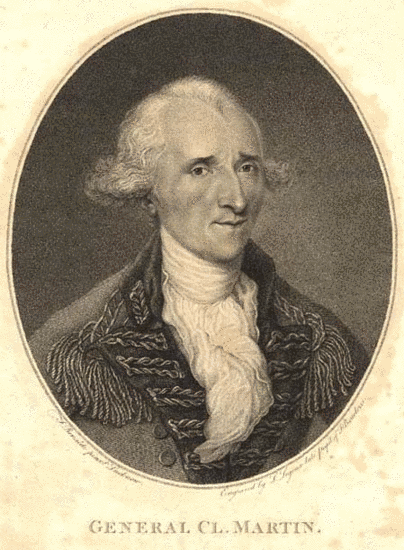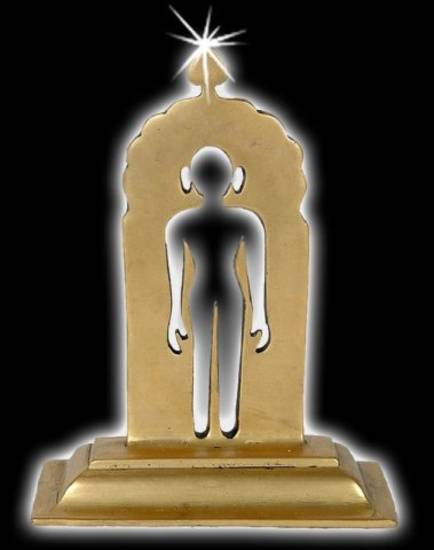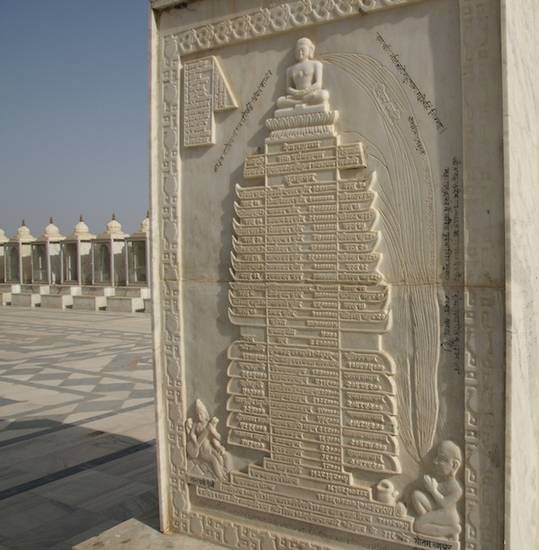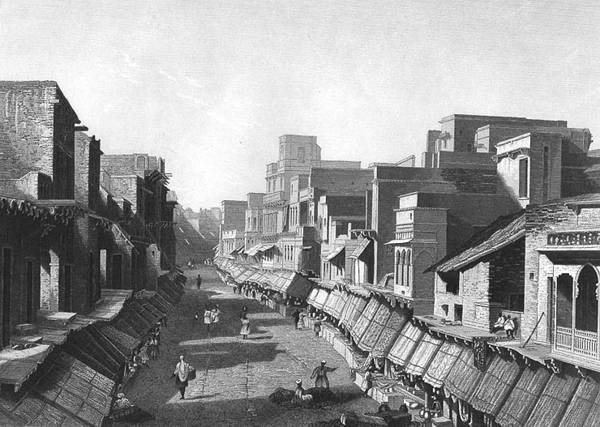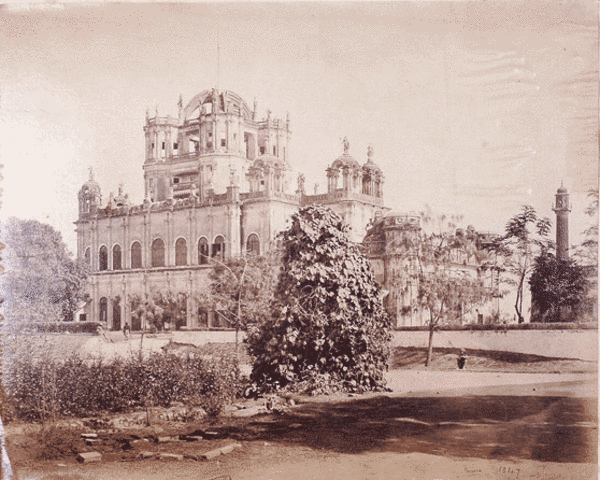Article: Karma-prakr̥ti
The so-called Karma-kāṇḍa manuscript in the Bodleian Library in Oxford is a very peculiar text. An 18th-century Persian translation of a 17th-century Braj commentary on a Prakrit treatise attributed to an 11th-century Digambara philosopher, it was commissioned by a wealthy Frenchman from an Indian Brahmin.
As one of the highlights of JAINpedia, it is remarkable for several reasons.
Firstly, the manuscript has a twin, found in the collection of the British Library in London, which is not available on JAINpedia. These two manuscripts are copies of one translation, produced in the same year by the same individual for one sponsor, but their paths to different British institutions are unknown. They seem to form a quartet with a similar pair of manuscripts.
Next, several languages and scripts appear in the manuscript. The original text is provided in Jaina Śaurasenī, a Middle Indic Prakrit used by Digambara scholars, and Sanskrit, along with the Persian translation of the commentary. The translation uses Indian and Arabic scripts, frequently badly written, making the manuscript hard to read without good knowledge of all the languages and scripts.
Then, the title under which both manuscripts have been catalogued is potentially misleading. The title of Karma-kāṇḍa was used by the Sanskrit commentator, but the text is usually called the Karma-prakṛti, which means ‘nature of karmic categories’. This latter title is used by the modern editor of the text. It deals with the religious doctrine of karma and is a technical work exploring the many details of the Jain concept. It is attributed to the Digambara thinker Nemicandra, whose most famous work, the Gommaṭasāra – Compendium [composed for] Gommaṭa – includes a lengthy examination of karma, called the Karma-kāṇḍa. The Karma-prakṛti may have been mistaken for this work, since it seems to share the same author and subject matter, and it may even have been a reworking of the Karma-kāṇḍa. The scholar Hiralal Shastri, editor of the 1964 modern edition, believes the Gommaṭasāra Karma-kāṇḍa is a reworking of the Karma-prakṛti.
The manuscript contains numerous inaccuracies of translation and explanation, which, coupled with poor penmanship, make the work difficult to understand. The Hindu translator seems to misinterpret Jain doctrine to chime with the beliefs of his own background and also introduces concepts and terms from Islam.
There is little information about the author, commentator, translator and sponsor of the manuscript but what there is shines interesting light on the creation of this unusual artefact.
The manuscript is undoubtedly perplexing in its mix of various languages, scripts and religious doctrine and terminology. However, this document stands at a crossroad of languages, religions and cultures as a rare testimony of the complex intercultural exchanges experienced by a Brahmin in late 18th-century India.
Two manuscripts
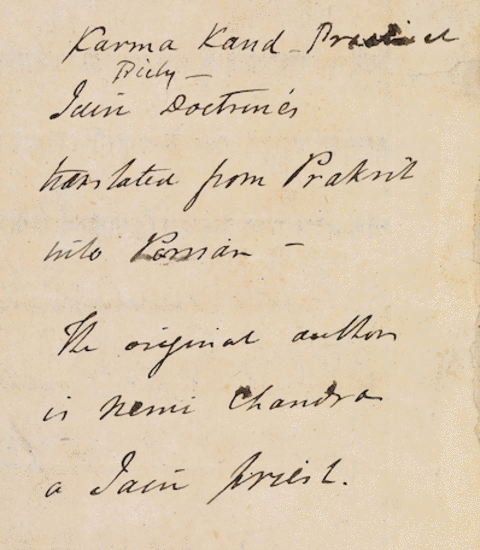
Title page of ‘Karma-kāṇḍa’ or ‘Karma-prakṛti’
Image by Bodleian Libraries, University of Oxford © Bodleian Libraries, University of Oxford
The Bodleian Library and the British Library each hold a manuscript copy of an otherwise unknown text. It is called Karma-kāṇḍa in the library catalogues, after the Persian and English headings on the first page of the text, where it is further described as a ‘Treatise (?) on Piety – Jain doctrines translated from Prakrit into Persian. The original author is Nemichandra a Jain priest’. The same handwriting is recognisable on both copies, which must have belonged to the same librarian or former owner before they were separated.
|
Institution |
Shelfmark |
Completion note |
|---|---|---|
|
Bodleian Library |
written on 21 July 1796 |
|
|
British Library |
Add. 25022 (folio 1 to 63) |
finished in May 1796 |
They appear to make up a set of four manuscripts, with two copies made of one text and two of another text. A French collector in India commissioned all four manuscripts in the 18th century but how they arrived in the UK in the 19th century is largely unknown.
All the manuscripts contain two scripts and three languages. The standard of copying is quite poor and some of the translations and interpretations of Jain concepts are inaccurate, making the manuscripts difficult to understand.
An interesting handwritten remark on the first page of the British Library manuscript calls it ‘A curious book’. It probably reflects the writer’s puzzlement faced with a fairly unintelligible text on what may look a dubious subject.
A following remark by another reader is even more telling: ‘[Jains] are very numerous and the Buddhists have merged with them’. It bears witness to general European ignorance about Jains at that time, which continued after the 1807 publication of Colebrooke’s seminal article. Entitled ‘Observations on the Sect of Jains’ the article clearly sets the Jain religion apart from other faiths in India. The translation of the commentary in this manuscript, however, does nothing to clarify the unique qualities of the Jain tradition.
Origins of the manuscripts
The two manuscripts catalogued as Karma-kāṇḍa in the Bodleian Library and the British Library seem to form a group with two other manuscripts. These other manuscripts have the same handwriting for headings in English and Persian, and are also copies of a single text, the Pancā-stikāyasāra – Compendium on the Five Entities – by Kundakunda.
The Bodleian Library holds one manuscript of each text, with the two other manuscripts in the collections of the British Library.
All the manuscripts were copied for Claude Martin, a French collector in India in the late 18th century. After his death his collection of Indian and Persian manuscripts was split up, with many now held in British institutions.
The manuscripts are written in a mixture of two scripts, representing three different languages. The writing in Devanāgarī, which is used for the text and its Sanskrit translation, is hard to read because of its poor quality.
‘Panchasat Gathas’
The two other manuscripts with the same handwriting are copies of a similar text, named as the ‘Panchasat Gathas fifty verses Exposition of Jain tenets’.
|
‘Panchasat Gathas’ manuscript |
Shelfmark |
|---|---|
|
Bodleian Library |
Wilson 261 |
|
British Library |
Add. 25022 (folios 64 to 224) |
However, the title in the libraries’ catalogues is incorrect, because it is based on a wrong reading of the transcription in Persian on the same page. This gives the original name as Pancāstikāya-sāra – Compendium on the Five Entities – which corresponds to a well-known book by the celebrated Digambara philosopher Kundakunda.
Journey to British libraries
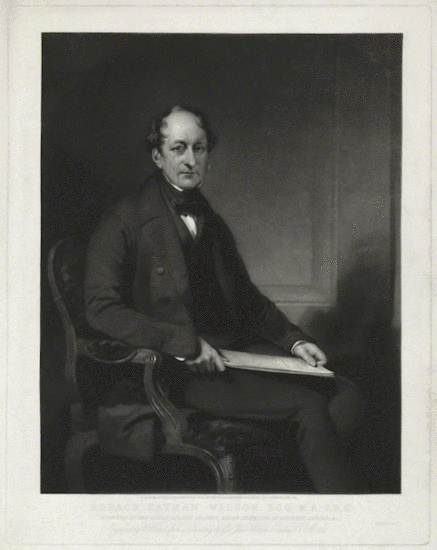
Horace Hayman Wilson
Image by William Walker, after Sir John Watson-Gordon © National Portrait Gallery, London
In 1842 the Bodleian Library bought a pair of manuscripts from the Oxford Sanskrit Professor, Horace Hayman Wilson. The British Library – at that time the British Museum – acquired the other two manuscripts in 1861, from a London bookseller, Bernard Quaritch. He was reputed to hold the largest catalogue of Oriental books in the West.
Unfortunately, only a small part of the history of these objects can be traced with certainty. They are believed to have been in the collection of the French polymath Claude Martin in Nawabi, Lucknow, as he commissioned the copies. They must have left Lucknow just after Claude Martin’s death in 1800, with the bulk of his Persian manuscripts sold at auction in Calcutta. Many of these manuscripts found their way into the libraries of famous scholars, such as Colebrooke. Most of them are now deposited in various libraries in the United Kingdom.
Languages and scripts
For these four manuscripts, the most striking feature is the presence of two different scripts – the Devanāgarī script and the Arabic script. Looking further, it becomes plain that behind these two scripts there are not only two languages, but three.
|
Text |
Language |
Script |
|
|---|---|---|---|
|
Nemicandra’s verses – gāthās |
Jain Śaurasenī, the standardised Middle Indian language used by Digambara philosophers in their verse work |
Devanāgarī |
|
|
Sanskrit translation of the verses, often called chāyā – ‘shade’ – in Sanskrit |
Sanskrit |
Devanāgarī |
|
|
Hemrāj’s commentary |
Persian – translation of the original Braj glosses |
Arabic script |
The Devanāgarī text is very badly written in all four manuscripts.
‘Karma-kāṇḍa’ or ‘Karma-prakṛti’?
Even though both the manuscripts in the British Library and the Bodleian Library are labelled Karma-kāṇḍa, the text belongs to a work more widely known as the Karma-prakṛti. These manuscripts follow the practice of various commentators, who designate the text as Karma-kāṇḍa. In the tradition there are thus two different names for a single work.
The Karma-prakṛti, a brief treatise on the nature of the bond between the soul and karma, is credited to Nemicandra, a thinker of the Digambara sect, who was active in the 11th century. The name for the Karma-prakṛti in these two manuscripts is the Karma-kāṇḍa, which is the same title as another, more famous, work attributed to Nemicandra. His Gommaṭasāra – Compendium [composed for] Gommaṭa – is divided into two parts, the second of which is the ‘Karma-kāṇḍa’ – ‘Chapter on Karma’.
There are strong similarities between these texts by Nemicandra, with identical verses used in both compositions. Some earlier scholars have tended to assume that Nemicandra wrote the Karma-prakṛti before the Gommaṭasāra but some modern scholars have disputed this convention. Dating texts from this era is difficult, with little firm evidence either way.
The practice of calling the Karma-prakṛti the Karma-kāṇḍa appears to be longstanding, with many historical sources using the latter name. It is likely, therefore, that the translator of these two manuscripts, along with other commentators and translators, knew this text as Karma-kāṇḍa. Despite this, however, contemporary scholars know the text as the Karma-prakṛti from its 1964 critical edition.
A later compilation?
The Karma-prakṛti‘s attribution to the Digambara philosopher Nemicandra is supported by the tradition, although there is no proof of this authorship. One traditional view holds that Nemicandra composed the Karma-prakṛti before his renowned Gommaṭasāra whereas another opinion in the tradition thinks it is a later work. The fact that a substantial number of verses from the Gommaṭasāra Karma-kāṇḍa and other texts are found in the Karma-prakṛti can be used to support either position.
Authors of commentaries on the Karma-prakṛti unanimously credit it to Nemicandra, but there is no decisive evidence available to support or disprove either outlook, as is common with historical Indian literature.
For the modern editor of the 1964 Karma-prakṛti, Hiralal Shastri, Nemicandra composed this text before the Gommatasara as it is aimed at helping beginners in karma theory. According to him, the Gommatasara would have come later for more advanced students. This represents a conservative view, which holds the tradition to be right until it is proven wrong. The editor also quotes other scholars who have expressed opposing opinions.
One example is Paramanand Shastri, who believes that the Gommaṭasāra Karma-kāṇḍa was faulty so Nemicandra decided to correct these errors by adding gāthās – verses – and creating a new text. Called the Karma-prakṛti, this new version was conceived as ‘a late compendium’ aimed at introducing students to the specific subject of karma (Introduction to Shastri 1964). Shastri claims that this later reworking was not done carefully, giving the example of verse 117 of the Karma-prakṛti, which is the same as verse 47 in the Gommaṭasāra Karma-kāṇḍa.
This table details how many of the 161 verses in the Karma-prakṛti are found in other works.
|
Source |
Number of verses |
|---|---|
|
Gommaṭasara: ‘Jīva-kāṇḍa’ and ‘Karma-kāṇḍa’ by Nemicandra |
102 |
|
Bhava-saṃgraha – Compendium on Being by Devasena |
16 |
|
May be composed for this work or from an unidentified source |
14 |
If the Gommaṭasāra came earlier, the Karma-prakṛti could have been based on the longer treatise. However, if the Gommaṭasāra is later, the author may have reused verses from his earlier text in the longer work.
Varying titles in different sources
Many historical sources use the title of Karma-kāṇḍa for the text in the manuscripts in the Bodleian Library and the British Library. However, it is usually known as the Karma-prakṛti in contemporary scholarship, after the title used in the 1964 critical edition.
The commentary by Hemrāj that accompanies the text in these manuscripts specifies Karma-kāṇḍa as the title.
iyam bhāṣā-ṭīkā Karma-kāṇḍasya paṇḍita hemarājena kṛtā svabuddhyanusāreṇa
This gloss[,] accompanied with a commentary of the Karma-kāṇḍa[,] was composed by Hemrāj Pande according to his own understanding
Translation by Jean Arzoumanov
Similarly, in his commentary at the beginning of the 17th century, Sumatikīrti names it Karma-kāṇḍa.
It is very probable that the translator thought of the text in these two manuscripts as the Karma-kāṇḍa, as his contemporaries would have done. This explains why he gave its title as the Karma-kāṇḍa.
However, the name chosen by Hiralal Shastri, the editor of the 1964 critical edition, is Karma-prakṛti. He does not fully justify his decision, but seems to take this title because one of the manuscripts he used to produce his work called it the Karma-prakṛti.
There are some examples online of this text being named Karma-prakṛti, such as this manuscript in Varanasi, India, available on the website of the International Digamber Jain Organization.
Summary of the ‘Karma-prakṛti’
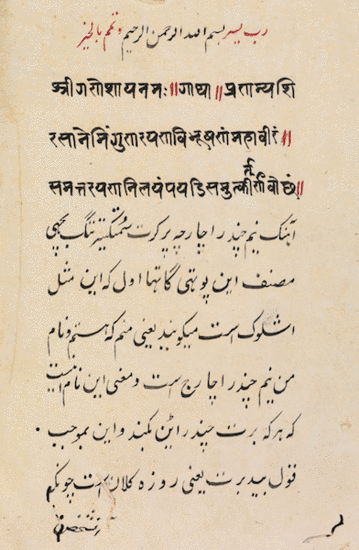
Triple invocation
Image by Bodleian Libraries, University of Oxford © Bodleian Libraries, University of Oxford
The rich collector Claude Martin commissioned the Brahmin Dilārām to translate into Persian Hemrāj’s commentary on the Karma-prakṛti, which is attributed to Nemicandra. Hemrāj’s original commentary was in the vernacular language of Braj, the main language for prose in this period, with some sentences in Sanskrit.
The title Karma-prakṛti means ‘nature of karma’, and this topic is explained in verse. Karma is a fundamental principle in Jain belief and is extremely complex and detailed, with numerous categories, effects and causes.
Dilārām opens his work with invocations in three languages, each appealing to a different god or prophet. These serve as an early indication of how the translation draws on the concepts and terminology of three separate faiths.
Dilārām carefully follows the ordering of the original verses but his translation stops with verse 87. Some verses are skipped in both the British Library and the Bodleian Library manuscripts, accounting for the different numbering in the modern edition, which includes all the verses.
Text details

Four types of existence
Image by Diwakar Prakashan / Padma Prakashan © Diwakar Prakashan / Padma Prakashan
The text begins with a triple invocation, as follows:
- the first line is in Arabic to Allah, and is conventional at the start of an Indo-Persian text
- the second line in Sanskrit, to Gaṇeśa, reflects Dilārām’s Hinduism
- the third in Śaurasenī, to the 22nd Jina Neminātha or Lord Nemi, serves as the first verse of the Karma-prakṛti.
Arabic
rabbi yassir; bismi ’llahi ’l-raḥmāni ’l-raḥīm; wa-tammim bi-l-khayr
O my Lord, give me ease; in the name of God, the Compassionate, the Merciful; and bring about a good end.
Sanskrit
śrīganeśāya namaḥ
I salute Lord Ganeśa.
Śaurasenī
paṇamiya sirasā ṇemiṃ guṇa-rayaṇa-vihūsaṇam mahāvīraṃ
sammatta-rayaṇa-ṇilayaṃ payaḍi-samukkittaṇaṃ vocchaṃ[= Karma-kāṇḍa verse 1]
Having bowed my head to Nemi, adorned with the jewel-like qualities of soul, the great hero, shrine of the jewels of the right belief, I will proclaim the nature [of karman].
All translations by Jean Arzoumanov
Verses 2 to 5
The union between soul and body is described as eternal and unbreakable. Because of the soul’s activity, the ‘soul body’ vibrates and attracts karmic particles, called karman – ‘action’ – by the Jains. The number of karmic particles is defined through calculation and is added to those shed after they have been exhausted or because of the soul’s activity.
Verses 6 to 14
These verses explain that karma is twofold, being both material as well as spiritual. It is divided into eight classes and 148 subclasses, which fall in the two main categories of:
Destructive karmans veil or stupefy the soul’s abilities. Karmans determine the soul’s:
- home within the cycle of reincarnation – saṃsāra
- existence
- condition in a type of being
- experience of pleasure and pain.
Verses 15 to 17
These verses define knowledge as threefold, consisting of:
- knowledge – jñāna
- vision or perception – darśana
- right belief – samyaktva here, although samyag-darśana is more common.
These are qualities of the soul along with energy – vīrya – which also relates to the physical body. Matter can be described according to sapta-bhaṅgi-naya – ‘formulation of sevenfold predication’ or ‘formula of seven assertions’.
Verses 18 to 21
In these verses the eight classes of karma are specified and ordered.
For example the destructive – ghātīya – karmas are ranked before the non-destructive – aghātīya – karmas. However, the fourth destructive karma – antarāya – is ranked last, after the non-destructive types of karma. This is because Nemicandra states that it is caused by the last three non-destructive karmas, which chiefly affect the physical body.
Verses 22 to 26
Verses 24 and 25 are missing in both manuscripts.
These verses explain how the union between body and karma is ‘compact and dense’ because there is an infinity of karmic particle on each spatial point of the soul.
The text describes how, when karma comes to fruition – udaya – it produces an effect – bhāva – on the soul. This effect is either:
These feelings of attraction or aversion are directed towards objects, people and emotions and take varying degrees of intensity.
Through this action of karma, other particles stick to the soul. The exception is the first non-destructive karma – ayus – which is the same throughout a single reincarnation.
Nemicandra further adds that karmic bondage must be distinguished according to its nature, duration, intensity and space.
In turn, the soul responds and attracts other karmans.
Verses 27 to 36
These verses define further the classes and subclasses of karma.
The author gives a simile for the eight types of karma – mūla-prakṛtis. For example, he describes darśana-āvaraṇīya-karma as being like a veil.
Verses 37 to 42
These verses divide the concept of knowledge into:
- direct knowledge – ābhinibodhaka-jñāna
- interpretative knowledge – śruta-jñāna
- extra-sensory knowledge or clairvoyance – avadhi-jñāna
- knowledge of others’ minds or telepathy – manaḥ-paryaya-jñāna
- omniscience or absolute knowledge – kevala-jñāna.
Verses 43 to 46
Verse 45 is missing in both manuscripts.
These verses categorise vision or perception – darśana – into:
- perception through the eyes – cakṣuṣ-darśana
- awareness of objects to the minutest atom – avadhi-darśana
- absolute perception – kevala-darśana – found in a soul that has achieved omniscience.
Verses 47 to 51
These verses describe how the four ‘destructive’ – ghātīya – karmans hinder true perception.
Verses 52 to 54
These verses explain how ‘destructive’ karmans can also dull correct perception because they involve wrong belief. Such incorrect beliefs are countered with spiritual peace.
Verses 55 to 65
These verses recount how the ‘destructive’ karmans can stupefy behaviour. They provoke passions – kaṣāyas – that lead the soul to be reborn. The four grades of passions determine where the soul is next reborn or embodied, which is in one of the four main places in the Jain universe.
The karmans can also raise no-kaṣāyas – a subgroup of passions or emotions. Nemicandra counts nine no-kaṣāyas, including the three vedas in this category.This type of karma determines the sex of the person, whether feminine, masculine or neuter.
Verses 66 to 67
These two verses describe how karmans determine the soul’s rebirth as a:
- divine being – deva-gati
- demonic being – naraka-gati
- human being – manuṣya-gati
- animal or plant being – tiryag-gati.
Verses 68 to 69
These two verses detail how the nāma-karmans determine which of the five bodies will be attached to the soul in its next birth. The five bodies are the:
- physical body – audārika-śarīra
- protean body – vaikriyika-śarīra
- translocation body – āhāraka-śarīra
- fiery body – taijasa-śarīra
- karmic body – kārmaṇa-śarīra.
Verses 70 to 82
Some karmans influence the physical body in which the imperfect soul is embodied during a ‘birth’. These verses describe how the nāma-karmans determine the body, which in Jain belief is made of atoms of matter – pudgala.
|
Type of nāma-karman |
Influence on the physical body |
|---|---|
|
Bandhana-karma |
affects the coherence of the body and the integration of new matter |
|
Saṃghātana-karma |
enables the atoms of pudgala to bind together |
|
Saṃsthāna-karma |
determines the body’s shape, for example whether it is:
|
|
Aṅgopāṅga-karma |
defines the body’s:
|
|
Saṃhanana-karma |
establishes the union between the bones, making the body more or less firm and strong. |
Verses 83 to 86
Saṃhanana-karma – which influences the body’s joints – also determines where the soul will be reborn, whether within the paradises or the hells. There is a complex correlation between the nature of the joints and the number of heavens and hells in which the soul can be born.
Verse 87
The saṃhanana-karma also determines the spiritual stage – guṇa-sthāna – which the soul is able to attain in a given lifetime.
The translation stops here although the original text comprises 161 verses. The translator, Dilārām, ends his work when the text starts to become extremely technical.
Commentary on the ‘Karma-prakr̥ti’
The 17th-century commentary by the Digambara scholar Hemrāj is fairly conventional in form. Primarily in Braj Bhāṣā, a vernacular language of northern India, the commentary contains numerous Sanskrit terms and phrases for technical concepts.
Form
The commentary loosely follows the traditional two-part form of the padārtha and bhāvārtha.
In the first stage, the padārtha, a short gloss of the words in the text gives their Sanskrit form, not their original Prakrit form, and their meaning. In the second stage – called the bhāvārtha – the subject matter is explained further. The commentator sometimes provides more detailed explanation of the gāthās, which are very succinct, on the whole.
Language
Hemrāj’s commentary is bilingual in the sense that it contains Sanskrit explanatory sentences followed immediately by a Hindi paraphrase. Yet although the commentary is written chiefly in Braj or Braj Bhāṣā, it contains many technical Sanskrit words from the Digambara doctrine.
Hemrāj may have been taken the explanations in Sanskrit from a previous commentary or may have composed them himself. They are sometimes similar to another anonymous Sanskrit commentary on the Karma-prakṛti.
The Sanskrit religious terms in the vernacular commentary are rarely explained, usually remaining unchanged. These Sanskrit-like words used in the vernacular are called tatsama – ‘identical’ in Sanskrit. These unexplained terms make it quite difficult for a student to use the commentary without proper guidance.
Most of the work is written in the local form of literary Hindi known as Braj or Braj Bhāṣā, which is still spoken in a vast area of northern India, including Agra. Before the emergence of modern Hindi in the 19th century, Braj was the main language of Hindu literature for several centuries across a larger area than nowadays. Although it is mainly thought of as a Hindu language, Jain scholars in the past often used it.
Translation
Translating the various languages of the text of the original work and its commentary into another language requires high levels of multi-lingual fluency. In addition, the Karma-prakr̥ti is a technical treatise on the complicated doctrinal topic of karma and a good grasp of the subject is needed to translate it accurately and convey the subtleties of Hemrāj’s commentary. However, the translation in the two so-called Karma-kāṇḍa manuscripts is frequently confusing, underscored by the epithet of ‘curious book’ added on the title page of the British Library copy. It highlights the likely bewilderment of readers struggling to make sense of the mixture of languages, scripts and religious doctrine in the manuscripts. Dilārām’s translation often blends Hindu and Muslim terms and references to explain what appear to be misunderstandings of Jain doctrine, expressed in poor Persian.
The translation is in Persian, the main language used for writing and administration in northern India for hundreds of years. The standard of the Persian in the manuscripts suggests that the translator’s knowledge of the language was imperfect, making the translation hard to understand.
Further, at some points the translator Dilārām transliterates Sanskrit into Arabic script, increasing the effort required to read the text.
One of the main difficulties in understanding the Karma-prakr̥ti in these two manuscripts arises from Dilārām’s translation and interpretation of Hemrāj’s commentary. Dilārām seems to misunderstand Jain doctrine and in some areas often obscures the Jain beliefs of the text by introducing terms and concepts from Hindu and Muslim thought. In some cases he uses Islamic terms for Hindu concepts to discuss aspects of Jain philosophy. Although these all make the original text hard to grasp, these elements point to an environment where ideas from various religious faiths were discussed freely.
Languages and scripts
The Karma-prakr̥ti was originally composed in Jaina Śaurasenī while the commentary is largely in Braj Bhāṣā and Sanskrit. Dilārām almost never translates the Sanskrit sentences in Hemraj’s commentary but he consistently translates the Braj Bhāṣā into Persian, the principal language of the period in North India, although his Persian is inaccurate in many places. He also provides some Sanskrit phrases in Arabic script.
Persian in northern India

East India House
Image by Thomas Malton the Younger, 1748-1804 © public domain
Persian was the dominant language in northern Indian society until the beginning of the 19th century and was for a long time the sole administrative language in Awadh. It was also the main language used by Europeans and employees of the East India Companies when dealing with local officials, employing a private scribe called a munshi as an intermediary.
The community of language and culture between the Persian territories and the Indian kingdoms created a continuous Perso-Islamic identity, extending the traditional Ajam, the non Arabic-speaking regions of the Muslim world, further to the east.
The use of Persian was particularly strong in the Nawabi realm and was used long after the emergence of Urdu among learned Muslim communities. However, in 1837 Urdu replaced Persian in the Nawabi court and in administration in the North Western Provinces. Even so, the Urdu spoken in Lucknow remained very close to Persian when it started to replace it as a written language.
Dilārām’s knowledge of Persian
The brahmin Dilārām mastered the Persian, Hindi and Sanskrit languages, which sets him apart from the usual method of translation in the previous centuries. In the 16th century the Mughal Emperor Akbar set up a translation bureau, where Hindu pandits and Muslim scribes worked together to produce Persian translations of Classical Sanskrit texts. This seems to have remained the most common way of producing translations in this period.
It is difficult to determine how and where Dilārām learnt Persian. His rather idiosyncratic style demonstrates that his command of Persian was not full, despite the claims at the end of his translation of the Karma-prakṛti.
Even if the many difficulties of the original text forced Dilārām to translate rather awkwardly, too many errors in the translation point to an incomplete education in Persian. The most striking feature is his use of plural forms. Dilārām uses Arabic internal plurals as singulars, adding the Persian suffix –hā when he wishes to form a plural.
Many other irregularities can be found on every page, making his translation difficult to read. He often uses various translations for a single technical term, further obscuring the overall meaning.
Transliteration of Sanskrit in Arabic script
One remarkable feature of the two manuscripts of the Karma-prakr̥ti is the presence of complete Sanskrit sentences written in Arabic script. The phonetic differences between Sanskrit and Persian make these transcriptions almost undecipherable for a casual reader. However, Hemrāj’s commentary helps gain a correct reading in most places.
On the whole, these sentences show a coherent transliteration system which shares much with previous attempts, such as those of Akbar’s translation bureau and Abu’l-Fazl’s Ain-i-Akbari and Dara Shikoh’s Sirr-e-Akbar.
Understanding the Persian translation
Dilārām’s translation of the commentary is faulty in several areas. Most seriously, he often reframes or explains Jain doctrine in misleading terms. Since the Karma-prakr̥ti discusses a key principle of the Jain religion – karma – in some detail, his translation could lead to a misunderstanding of the complexities of Jain beliefs. One reason for this apparent misinterpretation is that Dilārām often appears to approach the text from his own background in Hinduism, explaining theories in terms and analogies that are familiar to Hindus. Compounding this erroneous approach to Jainism is his frequent framing of Jain doctrine in Muslim expressions and concepts.
Dilārām’s translations of other Jain texts, such as the Pañcā-stikāyasāra, also reveal this approach.
Although he was a Hindu brahmin, Dilārām seems to have absorbed some Muslim concepts and terminology. This may be an indication of the diverse environment in which a Hindu worked for a European on a Jain text, in which tenets from one religion are freely explained in terms borrowed from others.
Misinterpretation of Jain doctrine
The Persian commentary on verse 81 is an example of how Dilārām’s argument goes beyond the original text and exemplifies how he misinterprets Jain doctrine and apparently twists it according to his own religious beliefs. In English it runs as follows:
[Sanskrit] … [Persian] i.e. you must know that the world is a mirage and as it is standing on the five [?], it cannot have permanence, because its foundation is similar to a morning dew; it is like snow which turns entirely into water when exposed to the sunlight. But you shouldn’t imagine [the world] as being without permanence. Therefore man must expose his devotion to Jain mati [Hindi for doctrine] and declare that he follows the discipline of God; i.e. people consider this religion as the most noble. Indeed for example, the Jinas, that is Jains’ religious leaders, have ordered them to behave with animals in accordance with dayā, that is compassion. In the same way, it is specified in the Veda that ahiṃsā paramo dharmaṃ [sic], which means not killing animals, is the most important belief
[Here follows the personal conclusion to the manuscript by Dilārām]
Translation by Jean Arzoumanov
Dilārām’s commentary suddenly breaks off after this point.
This excerpt illustrates how an evidently baffled Dilārām interpreted the text according to his own understanding of religion, making it fit into a broader Vedāntic or Hindu frame. Even though Dilārām specifies here one of the most important Jain tenets – ahiṃsā, meaning compassion and non-violence – it stands out as one of his scarce mentions of precise Jain doctrine. Coming right at the end, it suggests all the things the translator did not say in earlier parts, whether from ignorance or the way he wrote his commentary.
Another example is Dilārām’s definition of delusion – moha – as comprised of two types. The first is desire in the hereafter while the second is worldly desires. This distinction is absent from Hemrāj’s commentary. Within this eschatological framework, the enumeration of the heavens and the hells in the last gāthās is given a new meaning. Dilārām’s interpretation exceeds what is, above all, a technical exposition on saṃhanana-karma, which links the joints in the physical body to the various levels of the triple world in which the soul is born.
The translation stops here. The translator, Dilārām, ends his work when the text starts to become extremely technical.
Hindu influences
Dilārām’s brahmanic background permeates his translation and drives him away from the letter of the Karma-prakṛti. He constantly inserts comments at odds with Jain creed and which can be related to Advaita Vedānta (see D’Onofrio 2010 for the same diagnosis of the Sirr-i-Akbar, a 16th-century Persian translation of the Upaniṣads supervised by the Mughal prince Dara Shikoh).
A mystical or moral precept is often attributed to some aspects of the Jain text that are, at face value, completely devoid of it. Nemicandra’s Karma-prakṛti and Hemrāj’s commentary are more concerned with the subtleties of Jain psychophysics and not with directly moral teaching. This clearly dissatisfies Dilārām.
Dilārām refers constantly to the authority of the Vedas and to the dānāyān-i bīd or ʽālimān-i bīd –’knowers of the Veda’ – which borrows the Sanskrit word vedavid. He makes another reinterpretation according to classical Hinduism. In the commentary on verse 36, dealing with śruta-jñāna – ‘interpretative knowledge’ which is often used to refer to the teachings of the Jinas, handed down in the scriptures – Dilārām describes this technical Jain term as follows:
Śabdaśrutajñāna is good because in it are fixed the reading and the knowledge of the Vedas, the Purāṇas, the Śāstras and other texts, the way they are made understood to the student and the way they are understood by the teacher, their repetition by the student, the knowledge of God as He really is and the accomplishment of religious duties
Translation by Jean Arzoumanov
In another example, Dilārām glosses the different bandhas – ‘karmic bondage’ – in the commentary, when he quotes a devotional Hindi dohā – ‘couplet’ – by Tulsī Dās.
Who is completely free of worldly bonds and applies himself to the contemplation of God is called pradeśabandha because he knows his own nature and because the fruit of his actions [karma] is entirely burnt [away], which is. On this matter the Brahmin Śrī Tulsī Dās composed in his book written in bhāṣā that [here barely legible transliteration of the Hindi verse] ‘Rāma[G]’s name is like the burning fire, sins are like a mountain; when embers from this fire fall on the mountain, every sin is burnt and turns into ash’, there is no trace left. Concerning these bandhas, there are several peculiarities…
Wilson 262, folio 53 verso
Translation by Jean Arzoumanov
Hindu influences also appear in Dilārām’s other translations and commentaries, such as the Pañcāstikāyasāra.
However, an interesting aspect of the translations in this manuscript is Dilārām’s mixing of Muslim and Hindu terms and concepts.
Islamic terminology

Distortion of Jain doctrine
Image by Bodleian Libraries, University of Oxford © Bodleian Libraries, University of Oxford
Although Dilārām’s translation tends to approach and explain Jain doctrine through an apparently Hindu lens, he often uses Islamic terms for concepts found in Vedic thought. This mixture of Muslim and Hindu concepts and names suggests close interplay between Hindu and Persian cultural worlds in this period.
For example, Dilārām often refers to the concept of God using a Hindu framework but in terms taken from Islamic theology. In the original commentary on verse 1, Hemrāj glosses the word prakṛti with the words qudrat-i ḥaqq – ‘strength of God’, which is a proper Muslim theological term – and the Sanskrit word māyā – ‘creative illusion’. The word ‘prakṛti’ here means ‘nature, character’ but also means ‘nature (of the world)’ as a principle, which is associated in the Advaita Vedānta with māyā as a creative power and an attribute of God. The counterpart of māyā is avidyā – ‘ignorance’. Dilārām introduces these concepts when he says:
Māyā means knowing each thing as being the contrary of what it is; thus, according to the principles of the Vedic word, Allah is everywhere but man knows the contrary
Commentary on verse 58, folio 18 recto
Translation by Jean Arzoumanov
Thus Dilārām refers constantly to God, whom he calls ḥaqq and sometimes allah. God is described as the ‘absolute creator’ (kār-sāz-e moṭlaq Wilson 262, folio 29 recto, ḫāleq) under whose authority the world revolves. However, these expressions come directly from Islamic notions. The only Hindu name found in the text is Nārāyaṇa, which is a proper name of Viṣṇu (Wilson 262: verse 33 on folio 45 verso and verse 38 on folio 34 verso). Even so, Dilārām’s text can be described as largely Hindu creed in partly Islamic garb.
Dilārām’s distortions of the original commentary can also be found in this extract, translated into English:
The meaning of ṛjumati [simple knowledge] is that amongst devatās men revere one or two devatās, that is deities, but they ignore that the sole refuge is ātman, the creator of all creatures; apart from the sacred and supreme will of his generous and true essence, nothing exists; this is why man must place himself under the protection of the real God so that, trusting with hope in his heart’s truth and apart from other creatures, he may spend his life in safety and happiness; the meaning of vipula-jñāna [extensive knowledge] is that through it, we think that Nārāyaṇa is the lord of all deities.
Wilson 262, verse 38, folios 34 recto and verso
Translation by Jean Arzoumanov
In the same way, Dilārām’s discussion of salvation is not only Hindu but also Islamic. In this devotional context, salvation – najāt – as opposed to wandering and suffering – ʽaḏāb – plays an important part. The passions are the main obstacle to spiritual progress. Dilārām takes up the metaphor of a watchman who denies access to the king’s chamber and amplifies its mystical aspect:
As watchmen at the King’s door or in other places deny access to petitioners without the King’s order, likewise, desire, greed, avidity, etc, keep away from God’s way.
Wilson 262, verse 27, folio 49 verso
Translation by Jean Arzoumanov
In other words only those who truly know God, and thence honestly know themselves, can obtain salvation and perfect knowledge.
Dilārām often explains Hindu tenets in his translations and commentaries in terms and concepts taken from Islam. He may have done this when translating Jain texts into Persian to improve his readers’ understanding by framing concepts in more familiar terms. However, Dilaram’s Hindu background comes through strongly in his work and may be because he could grasp and express particular notions only from his own viewpoint and knowledge.
Dilārām uses predominantly Sufi terms to express properly Hindu notions. Examples include:
- reyāḍat – ‘discipline’ which is used to translate yoga in other Persian texts
- maʽrifat-i ḥaqq – ‘revealed knowledge of God’
- mušāhida – ‘contemplation’
- muršid – ‘master’
- murīd – ‘disciple‘.
These and other words form a semantic network that allows Dilārām to explain the Karma-prakṛti according to his own beliefs and also make it understandable to a reader of Persian. As a consequence, his commentary reflects the importance of Sufi Islam as a means to express and understand the divine and its experience in Indo-Persian culture. It is difficult to evaluate how far Dilārām was involved in Islamic culture but he was evidently interested and absorbed some of its key notions.
This insight into Dilārām’s literary world makes clear how free he feels to draw on different traditions to further his argument and shape a seemingly continuous flow of religious precepts, even at the risk of stretching the original text beyond recognition.
Author
The text known nowadays as Karma-prakṛti has been traditionally credited to the celebrated 11th-century Digambara philosopher Nemicandra. Often called Nemicandra Cakravartin, he is considered to have lived in modern Karnataka.
Nemicandra’s most influential work is the two-part Gommaṭasāra, which discusses the key Jain concepts of the soul and karma. His other writings are on points of doctrine.
His designation of cakravartin comes from the title Siddhānta-cakravartin – ‘Universal King of the Doctrine’. This refers to his mastery of the Digambara canon, called the Siddhānta.
Title of Nemicandra
Nemicandra is traditionally referred to as Siddhānta-cakravartin – ‘Universal King of the Doctrine’ – making him the first notable author to carry this regal title. It is justified through a metaphor by the author himself in the Karma-kāṇḍa.
jaha cakkeṇa ya cakkī cha-kkhaṇḍaṃ sāhiyaṃ aviggheṇa
taha mai-cakkeṇa mayā cha-kkhaṇḍaṃ sāhiyaṃ sammaṃ
[Just] As a Cakravartin conquers the six parts [of the Bharata Kṣetra] with the wheel of his chariot [cakra] without any hindrance, so the sixfold [treatise] [meaning the Ṣaṭkhaṇḍāgama] has been properly mastered by me through the cakra of intelligence.
Karma-kāṇḍa (Shastri, page 397)
Translation by Jean Arzoumanov
Commentator
The author of the Braj Bhāṣā commentary on the Karma-prakṛti is named in the manuscript as Hemarāja, more often known as Hemrāj Pande. From the Agravāl merchant caste, Hemrāj lived in Agra in the 17th century (Kaslival 1983) but few details of his life are known. Hemrāj was a disciple of Rūpcand, a thinker who had settled in Agra in 1635, where he gave a lecture on the Gommaṭasāra.
As a ‘pande’ – a vernacular form of the Sanskrit paṇḍita – or ‘pandit‘, Hemrāj Pande could have been a lay Jain administering the temple, appointed by a bhaṭṭāraka. Pandes were essentially ‘litterateursand intellectuals’ employed by temples to perform rituals and give public discourses (Cort 2002). They emphasised the necessity of both ritual and philosophy to achieve spiritual gains, whereas orthodox clerics stressed ritual practices.
In parallel to the traditional practice of religion, pandes formed the core of lay discussion circles. The well-known memoirist and writer Banārasīdās is the chief example of the Adhyātma movement, the most notable group, but as he does not mention Hemrāj it is impossible to establish whether Hemrāj was involved in this philosophical school. As John Cort underlines, ‘Jainism has long exhibited a tension between those who focus on religious knowledge (jñāna) of the fundamental principles of the tradition, and those who focus more on correct conduct and ritual observance (kriyā)’ (Cort 2002).
Hemrāj was a close friend of Kaurapāl or Kuṃvarapāl, who is mentioned by Banārasīdās in his autobiography, the Ardha-kathānaka. Kaurapāl asked Hemrāj to compose a commentary on Kundakuṇḍa’s Pravacana-sāra and Caurāsī Bol – Eighty-Four Disputes – a polemical work aimed at Śvetāmbaras. Surprisingly, Banārasīdās does not include Hemrāj among the prominent Digambara scholars in Agra (Jaini 2008). Hemrāj is first mentioned in 1644, by Hīrānanda, who describes him as ‘wise and cultivated’ in his Samavaraṇavidhāna (Kaslival 1983).
Kaslival (1983) references several works by Hemrāj, all written in the vernacular, that is Braj Bhāṣā. Hemrāj seems to have specialised in writing commentaries on texts by other scholars.
Translator
The text of the original work, the Karma-prakṛti, and the commentary are both translated into Persian by the brahmin Dilārām. Nothing is known of him except what he says in this translation and his translation of the Pancāstikāyasāra.
The translator introduces himself in the closing words of his work.
šukr īzid rā ki masthām dilārām brahman ki saṭrī dar ᶜilm-i saṃskṛta va hunar-i pārsī qiyāfa dārad tarjuma-yi īn pūthī-e jayn matī rā ki Karma-kāṇḍanām dārad ba mūjib-e iršād-i bandagān-i ḥuḍūr-i fayḍ-i ganjvar-e šaraf al-dawla sayf al-mulk imtiyāz ḫān jirnīl klūd mārtīn ṣāḥib bahādur šahāmat jang […] bā tamām rasānīda būd
Thanks be to God that Masthām Dilārām, brahmin, who has mastered writing in the science of Sanskrit and in the art of Persian appearance [?] has brought to a close the translation of this book [pūthī] about the Jain religion [matī] called Karma-kāṇḍa, at the behest of the servants of His Excellence, by the grace of the Treasurer of the most Noble in this world, Sword of the Kingdom, his distinguished Lordship, General Claude Martin, Valiant, Audacious in Combat.
Bodleian Library, Wilson 262, folio 1 recto
Translation by Jean Arzoumanov
In his translation of the Pañcā-stikāyasāra he presents himself as Masthām Dilārām, son of Mansārām, a brahmin, resident of a small city in the district of Sambhal. In modern Uttar Pradesh, this place is quite far from Lucknow, where Dilārām completed his two known translations.
Sponsor
As Dilārām indicates at the end of the text, his Persian translation was commissioned by ‘General Claude Martin’, who was quite a famous character in 18th-century Lucknow. Martin has been the subject of several biographies, the latest being the work of Rosie Llewellyn-Jones (1992).
Born in Lyon in 1735, Martin worked as an apprentice for a silk-weaver before enrolling at the age of 16 in the Compagnie des Indes, the French counterpart of the East India Company. After serving for eight years in India in the ranks of the French army, he turned to the British side, which has sometimes been judged an opportunistic move. He started a successful career in the East India Company in spite of being French, which made him potentially suspicious in the company’s eyes. In 1776 Martin settled in Lucknow, the new capital of Awadh State and now the capital of modern Uttar Pradesh.
At the end of the 18th century Awadh, which the British spelled Oudh, was the most prosperous region in northern India. Formally a representative of the Mughal emperor, the Nawabi dynasty gradually broke free of central authority during the 18th century and reached a golden age before the rise of the British power in Awadh in the early 19th century.
After long petitioning the Governor-General in Calcutta, Claude Martin was made honorary major-general at Lucknow in 1795. He used this position at the Nawabi court to set up various businesses, such as silkworm breeding, and became one of the richest Europeans in India. As an amateur engineer and architect, he also designed several luxurious mansions, some of which are still standing in the city, and is also remembered as the first person to launch a hot-air balloon in Lucknow. In many ways he is the archetypal 18th-century polymath, heir of the Enlightenment.
Martin’s interests also encompassed India’s culture, religions and scripts. He regularly bought orientalist works and original manuscripts in Sanskrit and Persian. This was sometimes achieved through dubious means, as reported by the Comte de Modave, who was shown ‘several rarities by Martin, which had been appropriated in some temples of the Boutans. He even gave me several manuscripts which he had taken from inside the statues. I sent them to the Académie des Inscriptions’ (Deloche 1971: 106). Martin also joined the Asiatic Society of Bengal in 1799. He died in 1800 and left an enormous fortune, which he bequeathed for the founding of three high schools called Martinière. One was to be established in his hometown, Lyon, one in Calcutta and one in Lucknow, and all are still operating.
The inventory of Martin’s collection made on his death states that some 500 Persian manuscripts were sent to Calcutta after he died. Unfortunately, their names are not given and no further information can be obtained. His collection was probably one of the biggest of any European in India in that time.
Reading
- ‘A Tale of Two Cities: On the Origins of Digambar Sectarianism in North India’
John E. Cort - Multiple Histories: Culture and Society in the Study of Rajasthan
edited by Lawrence A. Babb, Varsha Joshi and Michael W. Meister
Rawat Publications; Jaipur, Rajasthan, India; 2002
- Voyage en Inde du Comte de Modave 1773–1776
Jean Deloche - Ecole Française d’Extrême Orient; Paris, France; 1971
- Kavivar Bulākhīchand Bulākīdās, evaṃ Hemarāj
Kasturchand Kāslīvāl - Mahāvīra Grantha Academy; Jaipur, Rajasthan, India; 1983
- Śrī Nemicandrācāryakṛta Karma-prakṛti
- translated and edited by Hīrālāl Śāstrī
Jñānapītha Mūrtidevī Jaina Granthamālā Prākrit Grantha series; volume 11
Bhāratīya Jñānpīṭh; Varanasi, Uttar Pradesh, India; 1964
- Lucknow: The Last Phase of an Oriental Culture
Abdul Halim Sharar - translated by E. S. Harcourt and Fakhir Hussain
Paul Elek; London, UK; 1975
Links
- Bernard Quaritch Ltd Booksellers
-
History of the company Bernard Quaritch Ltd, a leading antiquarian book dealer established in 1847. He was reputed to hold the largest catalogue of Oriental books in the West, and handled the sales of books and manuscripts among scholars, collectors, universities and museums.
- Will of Claude Martin
-
The text of the will of Claude Martin is provided on Wikisource. French-born Martin had risen within the British East India Company to become a prominent figure in Lucknow in the late 18th century. A successful businessman and polymath, he was close to the ruling nawab and was an architect, amateur scientist, art connoisseur and collector of Indian cultural artefacts. He commissioned the Persian translation of the Karma-kāṇḍa or Karma-prakrti, one of the Highlights of JAINpedia.
- Nawab of Awadh
-
Wikipedia provides information about the wealthy rulers of the historical state of Awadh or Oudh in northern India in the 18th and 19th century. Originally representatives of the Mughal emperor, the nawabs gradually became independent rulers.
- Images of Shravana Belgola
-
The best-known Digambara pilgrimage site, Shravana Belgola in Karnataka is centred around the immense statue of Bahūbali. Depicted standing in deep meditation, the statue has drawn pilgrims and interest from visitors since the tenth century. This collection of drawings and photographs is presented by Professor Frances W. Pritchett of Columbia University in New York.
- +
- aAbhavya
- aAbhinandana
- aAbhiṣeka
- aĀcāra
- aĀcārāṅga-sūtra
- aĀcārya
- aAchalbhrata
- aAḍhāī-dvīpa
- aAdharma
- aAdho-loka
- aAdhyayana
- aAdvaita Vedānta
- aĀgama
- aAghātīya
- aAghātīya-karman
- aAgnibhuti
- aAgra
- aĀhāra
- aAhiṃsā
- aAhimsa Day
- aAjita
- aAjīva
- aAkampit
- aĀkāśa
- aAkbar the Great
- aAkṣaya-tṛtīyā
- aAlauddin Khalji
- aAlbert Einstein
- aAllah
- aAlms
- aĀlocanā
- aAloka-ākāśa
- aAmāri
- aAmbikā or Kūṣmāṇḍinī
- aAnagāra
- aAnanta
- aAnarthadaṇḍa
- aAnaśana
- aAnekānta-vāda
- aAṅga
- aAniconism
- aAnojjā
- aAntarāla
- aAntarāya-karma
- aAṇu
- aAṇu-vrata
- aAnukampā
- aAnuprekṣā
- aAnusvāra
- aApabhraṃśa
- aAparigraha
- aAra
- aĀrambha
- aĀrambhaja
- aĀratī
- aArdhamāgadhī Prākrit
- aArhaṃ
- aArhat
- aArśana-āvaraṇīya-karma
- aĀrta-dhyāna
- aĀryikā
- aĀryikā Jñānamati
- aĀśātanā
- aĀścarya
- aAscetic
- aAsceticism
- aAshram
- aAspiration
- aĀsrava
- aAṣṭa-maṅgala
- aAṣṭāpada
- aAstikāya
- aAstrolabe
- aAsura
- aAtheism
- aAticāra
- aAtiśayakṣetra
- aAtithisaṃvibhāgavrata
- aĀtma-vāda
- aĀtman
- aAuṃ
- aAurangzeb
- aAuspicious
- aAusterity
- aAvadhāna
- aAvadhi-jñāna
- aĀvaraṇī-yakarman
- aAvasarpiṇī
- aAvatāra
- aAvidyā
- aAxiom
- aĀyāga-paṭa
- aĀyambil
- aĀyu-karma
- aĀyurveda
- bBabur
- bBāhubali
- bBaladeva
- bBālāvabodha
- bBandha
- bBasadi
- bBazaar
- bBhadrankarvijay
- bBhagavant
- bBhaktāmara-stotra
- bBhakti
- bBhale
- bBharata
- bBhāṣā
- bBhāṣya
- bBhaṭṭāraka
- bBhāva
- bBhāva-pūjā
- bBhāvanā
- bBhavana-vāsin
- bBhavya
- bBhavyatva
- bBhaya
- bBhoga-bhūmi
- bBhogopabhoga
- bBodhi
- bBollywood
- bBrahmā
- bBrahma-deva
- bBrahmacārī
- bBrāhmaṇa
- bBraj Bhāṣā
- bBright fortnight
- bBritish Raj
- bBuddha
- bBuddhi-sagar
- bBuddhism
- bBuddhist
- cCaitya
- cCaityavāsin
- cCakravartin
- cCakreśvarī
- cCāmara
- cCandanā
- cCandragupta
- cCandraprabha
- cCanon
- cCāritra
- cCāritramohanīya-karman
- cCarũrī
- cCaste
- cCaturvidha-saṅgha
- cCaturviṃśati-stava
- cCāturyāma
- cCE
- cCelibacy
- cCha
- cChadmastha
- cChastity
- cCheda-sūtra
- cChristian
- cChristianity
- cClergy
- cCloning
- cColophon
- cCommentary
- cConch
- cConfession
- cCongregation
- cConsecration
- cCosmology
- cCremation
- cCrore
- cCult
- cCūrṇi
- dDādā-guru
- dDalit
- dDāna
- dDaṇḍa
- dDark fortnight
- dDarśana
- dDarśanamohanī-yakarman
- dDaśa-lakṣaṇa-parvan
- dDeity
- dDelhi Sultanate
- dDerāsar
- dDeśāvakāśika-vrata
- dDetachment
- dDevanāgarī
- dDevānandā
- dDevarddhi-gani
- dDevotee
- dDhamal
- dDhanuṣ
- dDhāra
- dDharma
- dDharma-dhyāna
- dDharma-sāgara
- dDharmastikaya
- dDhātakīkhaṇḍa
- dDholak
- dDhyāna
- dDiaspora
- dDig-vrata
- dDigambara
- dDīkṣā
- dDisciple
- dDīvālī
- dDivya-dhvani
- dDNA
- dDoctrine
- dDogma
- dDonor
- dDoṣa
- dDravya
- dDravya-pūjā
- dDrone
- dDuṣamā
- dDuṣamā-duṣamā
- dDuṣamā-suṣamā
- dDveṣa
- dDvīpa
- eEast India Company
- eEightfold Path
- eEkānta-vāda
- eEkendriya
- eElder
- eElders
- eEschatology
- eEtc up to
- fFarmān
- fFast
- fFatehpur Sikri
- fFestival
- fFestschrift
- fFiruz Shah
- fFly-Whisks
- fFolio
- fFour Noble Truths
- gGaccha
- gGaṇa
- gGaṇadhara
- gGanadharavada
- gGaṇeśa
- gGaṇin
- gGarba
- gGarbha
- gGarbha-gṛha
- gGaruḍa
- gGati
- gGene
- gGenomics
- gGhātī-yakarman
- gGhātīya
- gGhaznavid
- gGhiyasuddin Tughlaq
- gGhurid
- gGloss
- gGotra-karma
- gGujarāt
- gGujarati
- gGuṇa
- gGuṇa-sthāna
- gGuṇa-vrata
- gGupti
- gGuru
- gGuruṇī
- hHagiography
- hHajj
- hHaṃsa
- hHaribhadra
- hHariṇaigameṣin
- hHasta
- hHeresy
- hHiṃsā
- hHindi
- hHindu
- hHinduism
- hHīravijaya
- hHoroscope
- hHrīṃ
- hHumayun
- hHymn
- iIconoclasm
- iIconography
- iIdol
- iIndian Independence
- iIndology
- iIndra
- iIndrabhūti Gautama
- iIndriya
- iInitiation
- iIntercession
- iInvocation
- iIQ
- iIslam
- iIslamicate
- iIṣṭadevatā
- iĪśvara
- jJagat
- jJahangir
- jJain
- jJaina Devanāgarī
- jJaina Śaurasenī
- jJaina-dharma
- jJainaśāsana
- jJainness
- jJaisalmer
- jJamāli
- jJambū-dvīpa
- jJames Burgess
- jJanma
- jJanma-kalyāṇa
- jJarā
- jJāti
- jJina
- jJina-āgama
- jJina-bhavana
- jJina-bimba
- jJina-mātā
- jJinacandra-sūri
- jJinadatta
- jJinaprabha
- jJīva
- jJñāna
- jJñāna-āvaraṇīya-karma
- jJñāna-āvarṇiya
- jJñānsundar
- jJyotiṣka
- kKāla
- kKālakācārya-kathā
- kKālidāsa
- kKalpa-sūtra
- kKalpa-vṛkṣa
- kKalyāṇaka
- kKalyanvijay
- kKamaṇḍalu
- kKamaṭha
- kKarma
- kKarma-bhūmi
- kKarma-grantha
- kKarma-prakṛti
- kKarma-vāda
- kKarmon
- kKarnataka
- kKaṣāya
- kKathā
- kKāvya
- kKāya
- kKāyotsarga
- kKeśa-loca
- kKetu
- kKevala-jñāna
- kKevalin
- kKhalji
- kKharatara-gaccha
- kKnowledge
- kKriyā
- kKriyā-vāda
- kKṛṣṇa
- kKṣamā-śramaṇa
- kKṣapakaśreṇi
- kKṣatriya
- kKṣullaka
- kKulakara
- kKundakunda
- kKunthu
- lLabdhi
- lLaity
- lLakh
- lLāñchana
- lLands of Action
- lLaukāntika
- lLavaṇa-samudra
- lLeśyā
- lLiṅga
- lLinguistics
- lLoka
- lLoka-ākāśa
- lLoka-puruṣa
- lLoka-vāda
- lLotus
- lLotus lake
- mMadhya-loka
- mMahā-videha
- mMahā-vrata
- mMahābhārata
- mMahāmastakābhiṣeka
- mMāhārāṣṭra
- mMāhārāṣṭrī Prākrit
- mMahattarā Yākinī
- mMahāvīr Jayantī
- mMahāvīra
- mMakāra
- mMakkhali Gośāla
- mMalli
- mMāna-stambha
- mManaḥ-paryāya-jñāna
- mMaṇḍala
- mMaṇḍapa
- mMandit
- mMaṅgala
- mMantra
- mMantras
- mManuṣya-loka
- mMarāṭhī
- mMārgaṇā
- mMartyr
- mMarudevī
- mMaṭha
- mMati-jñāna
- mMauryaputra
- mMecca
- mMendicant lineage
- mMetarya
- mMiracle
- mMithyādṛṣṭi
- mMohandas Gandhi
- mMohanīya-karma
- mMokṣa
- mMonastic order
- mMonasticism
- mMonk
- mMonotheism
- mMosque
- mMount Meru
- mMount Sammeta
- mMṛgāvatī
- mMughal
- mMuhammad
- mMuhammad bin Tughlaq
- mMuhpattī
- mMūla-sūtra
- mMūlaguṇa
- mMumbaī
- mMuni
- mMunisuvrata
- mMurad Bakhsh
- mMūrti-pūjaka
- mMuslim
- mMysticism
- nNābhi
- nNāga-kal
- nNāgapurīya Tapā-gaccha
- nNāgarī
- nNāma-karma
- nNamaskāra-mantra
- nNami
- nNandīśvara-dvīpa
- nNandivardhana
- nNandyāvarta
- nNāraka
- nNāraki
- nNasalisation
- nNātha
- nNavrātrī
- nNaya-vāda
- nNemi
- nNidāna
- nniggaṃthāṇa vā 2
- nniggaṃtho vā 2
- nNigoda
- nNihnava
- nNikṣepa
- nNirgrantha
- nNirjarā
- nNirvāṇa
- nNiryukti
- nNiṣidhi
- nNitya
- nNiyati
- nNo-kaṣāya
- nNudity
- nNun
- oOcean of milk
- oOmniscience
- oOrdination
- ppa°
- pPadmaprabha
- pPadmāsana
- pPadmāvatī
- pPādukā
- pPalanquin
- pPalette
- pPañca-muṣṭi
- pPāṇḍava
- pPaṇḍit
- pPandit Dalsukh D. Malvania
- pPandit Sukhlalji
- pPāṇipātra
- pPāpa
- pParamātman
- pParameṣṭhin
- pPāraṇā
- pParigraha
- pPariṇāma
- pParīṣaha
- pParokṣa
- pPārśva
- pPārśvanātha
- pParyāya
- pParyuṣaṇ
- pPaṭa
- pPatan
- pPātra
- pPenance
- pPersian
- pPhala
- pPhilology
- pPicchikā
- pPilgrimage
- pPīr
- pPolymath
- pPoṣadha
- pPossession
- pPothī
- pPrabhas
- pPradakṣiṇā
- pPradeśa
- pPrākāra
- pPrakīrṇaka-sūtra
- pPrākrit
- pPramāda
- pPramukhā
- pPrati-vāsudeva
- pPratikramaṇa
- pPratimā
- pPratiṣṭhā
- pPratyākhyāna
- pPratyakṣa
- pPravacana
- pPrāyaścitta
- pPrayer
- pPre-modern
- pPreach
- pPredestination
- pProtestant
- pProvenance
- pPudgala
- pPūjā
- pPujārī
- pPukharavara-dvīpa
- pPuṇya
- pPūrva
- pPuṣkara-dvīpa
- pPuṣpadanta
- pPyre
- qQur’an
- rRāga
- rRāhu
- rRainy season
- rRajasthan
- rRajasthani
- rRājimatī
- rRajoharaṇa
- rRajput
- rRāma
- rRāmāyaṇa
- rRangoli
- rRās-garbā
- rRasa
- rRathanemi
- rRatna-traya
- rRātri-bhojana
- rRaudra-dhyāna
- rRecto
- rRelic
- rRenunciation
- rRetroflex
- rRevatī
- %Ṛg-veda
- rRite
- rRosary
- %Ṛṣabha
- %Ṛṣabhanātha
- rRupee
- sSaciyā Mātā
- sSādhu
- sSādhvī
- sSāgāra
- sSaint
- sŚaivaism
- sŚaka-saṃvat
- sSallekhanā
- sŚalya
- sSamacatuṣṭha
- sSamādhimaraṇa
- sSamaṇi
- sSāmarambha
- sSamavasaraṇa
- sSāmāyika
- sSaṃbhava
- sSamiti
- sSaṃjñā
- sSaṃkalpaja
- sSaṃsāra
- sSamudghāta
- sSaṃvara
- sSaṃvega
- sSamyak-cāritra
- sSamyak-darśana
- sSamyak-jñāna
- sSamyaktva
- sSaṃyama
- sSanctuary
- sSandalwood
- sSaṇgha
- sSanskrit
- sSant
- sŚānti
- sSapta-bhaṅgi-naya
- sSārambha
- sSarasvatī
- sSarvajña
- sSāsan-devi
- sŚāsana-devatā
- sŚāstra
- %Ṣaṭ-jīvanikāya
- sSatī
- sSatīmātā
- sSatya
- sSchism
- sScribe
- sScripture
- sSect
- sSecularism
- sŚenāī
- sSermon
- sŚeṣavatī
- sSevā
- sSeven fields of donation
- sShah Jahan
- sShantidas Jhaveri
- sShrine
- sSiddha
- sSiddha-śilā
- sSiddhacakra or Navadevatā
- sSiddhānta
- sSiddhārtha
- sSiddhi
- sSikh
- sSikhism
- sŚikṣā-vrata
- sŚīla
- sSin
- sSindh
- sŚītala
- sŚiva
- sSkandha
- sSomanatha
- sŚraddhā
- sŚramaṇa
- sŚrāvaka
- sŚrāvakācāra
- sŚrāvikā
- sŚreyāṃsa
- sŚrī
- sŚrīvatsa
- sŚruta-jñāna
- sŚruta-pañcamī
- sSthānaka-vāsin
- sSthāpanācārya
- sSthāvara
- sSthavira
- sSthiti
- sStrīmukti
- sStūpa
- sSubcontinent
- sSudarshana
- sŚuddhi
- sSudharma
- sŚūdra
- sSufism
- sSukha
- sŚukla-dhyāna
- sSulasā
- sSultan
- sSumati
- sSundarśrī
- sSupārśva
- sSūri
- sSuṣamā
- sSuṣamā-duṣamā
- sSuṣamā-suṣamā
- sSūtra
- sSuyam me ausam! Tenam bhagavaya evamakkhayam
- sSvādhyāya
- sSvāhā
- sSvastika
- sŚvetāmbara
- sŚvetāmbara Terāpanthin
- sŚvetāmbaras
- sSwan
- sSyād-vāda
- tTabla
- tTantra
- tTapā-gaccha
- tTapas
- tTāraṇ Svāmī Panth
- tTattva
- tTattvārtha-sūtra
- tTemple
- tTemple-city
- tThe Enlightenment
- tTheology
- tThree worlds
- %Ṭīkā
- tTilaka
- tTīrtha
- tTīrthaṃkaranāma-karman
- tTīrthankara
- tTransliteration
- tTrasa
- tTrasa-nāḍī
- tTriśalā
- tTriṣaṣṭi-śalākā-puruṣa-caritra
- tTti bemi
- tTughlaq
- tTunk
- uUdumbara
- uUniversal History
- uUpādhyāya
- uUpāṅga
- uUpaniṣads
- uUpāsaka
- uUpasarga
- uUpāśraya
- uŪrdhva-loka
- uUtsarpiṇī
- uUttarādhyayana-sūtra
- vVāhana
- vVaimānika
- vVairāgya
- vVaiṣṇava
- vVaiśramaṇa
- vVaiśya
- vValabhī
- vVanaspatikāya
- vVandana
- vVaṇik
- vVarṇa
- vVāsudeva
- vVāsupūjya
- vVayubhūti
- vVeda
- vVedanīya-karma
- vVegetarianism
- vVehicle
- vVernacular
- vVerso
- vVidyā
- vVidyā-devī
- vVihāra
- vVijñapti-patra
- vVikrama-saṃvat
- vVikṛti
- vVimala
- vVinaya
- vVipāka
- vVirji Vora
- vVirodhaja
- vVīrya
- vVisarga
- vViṣṇu
- vVītarāga
- vVizier
- vVotive
- vVow
- vVrata
- vVS
- vVyakta
- vVyantara
- vVyasana
- yYakṣa
- yYakṣī
- yYantra
- yYaśoda
- yYaśovijaya
- yYati
- yYātrā
- yYoga
- yYoginī
- yYojana


